
A walking trail in Kruger is the best way to make the bush come alive. Did you know only six percent of the Kruger National Park is accessible to visitors via the main public roads? Isn’t it time you explored the other 94 percent? You can do that on these eight amazing walks we tested. Written by Melanie van Zyl, with Pafuri section by Anton Crone.
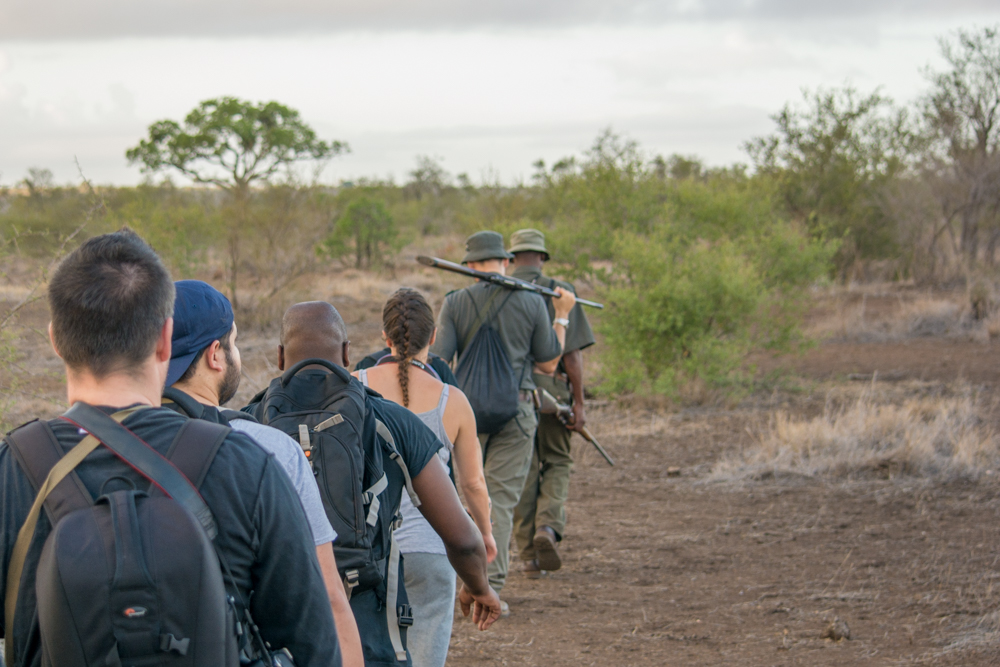
Photo by Melanie van Zyl.
Also read: walking trails to make you fall in love with Kruger
Multi-day walking trails in Kruger
1. Olifants Wilderness Trail
The Olifants Wilderness Trail is a three-night foray along the Olifants River for walkers keen on experiencing the smaller details of the reserve without the barrier of a vehicle. Humans are pretty bad at keeping quiet, easy to smell and seen as the ultimate predator, so experiencing big mammals on foot is rare.
Still, nothing makes you feel your mortality more keenly than knowing there’s lion nearby. And you’re on foot. Your heart thunders and every single sense is so heightened you discover you’re really just an animal seeking survival too.
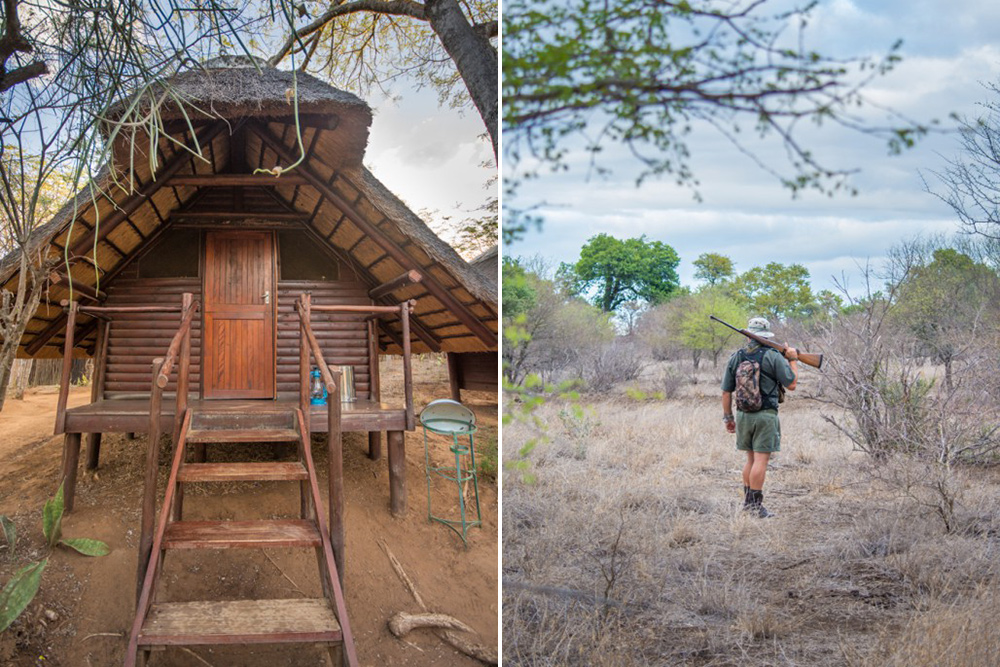
Left: our homes for three nights. Each A-frame sleeps two and there are four in total. If you don’t completely book out the walk with eight people, you could bunk with people you don’t know. Right: on all walks you are accompanied by two experienced rangers equipped with rifles.
We set off at dawn, our guides, Steven Oosthuizen and Excellent Hlatshwayo in the lead, each armed with a rifle. Branches snapped, grass crunched and the drought-stricken landscape did little to hide us from possible predators. Now and then we stopped to read the bushveld.
‘Tannins in leaves turn the dung of browsers like elephant and black rhino a russet red when it’s fresh,’ said Steven. He nudged the fresh deposit with his boot and outlined the enormous elephant spoor showing the direction in which it had ambled.
‘It must have been here about an hour ago, and they move quickly. I don’t think we’ll catch him.’ He pointed out the flies next.
‘These blue flies often indicate there’s a carcass nearby.’

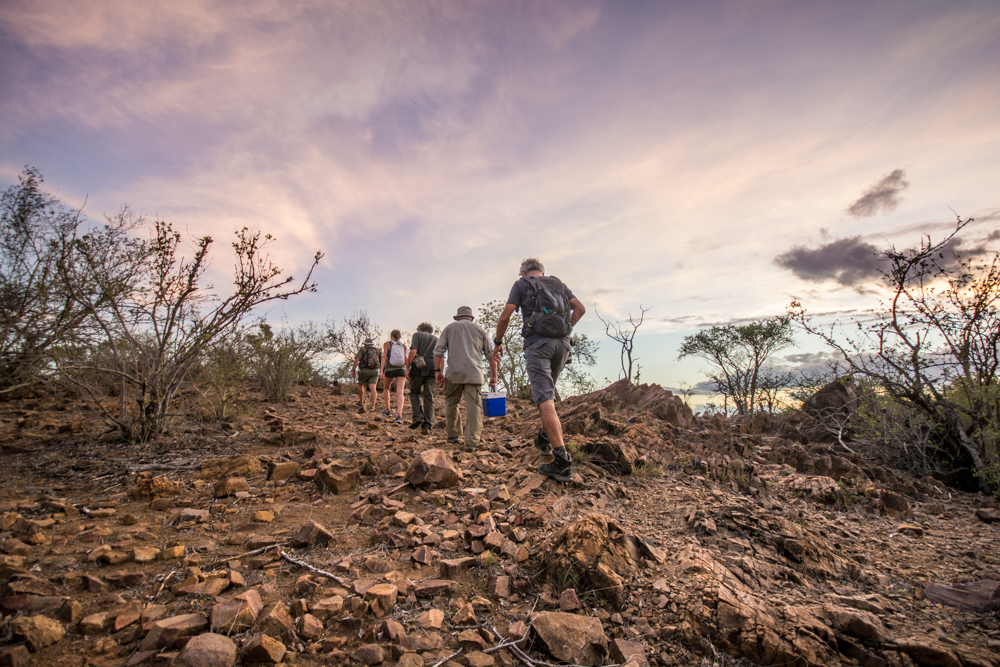
The Olifants Wilderness Trail caters to a maximum of eight people and consists of several morning and afternoon walks from a private bush camp. Photo by Melanie van Zyl.
Nearly a half hour later the bush started cracking loudly. We moved slowly into a clearing where an elephant was eating less than 60 metres way. Excellent turned his head, listened to another sound nearby and told us to move again.
‘Did you hear that?’ he asked me.
I heard a low grumbling, but thought it was the ellie. ‘No, that was definitely lion.’ We watched the pachyderm and strained to listen for the lion. With nothing but nature between the big bull and us, it started to move in our direction. We decided not to overstay our welcome and moved on.
Useful info about the Olifants Wilderness Trail
Each day’s walk is an average of five to six kilometres and takes roughly four hours (walks may be shortened due to weather). There’s no hard climbing or intense bundu-bashing, but relative fitness is still recommended. Bring binoculars, a camera, comfy walking shoes and neutral, dark clothing plus a hat. Books and games are great for the midday chill time.
Cost: R4500 per person, including accommodation in A-frame log cabins at Olifants Bush Camp, all meals and two walks a day.
Book: sanparks.org
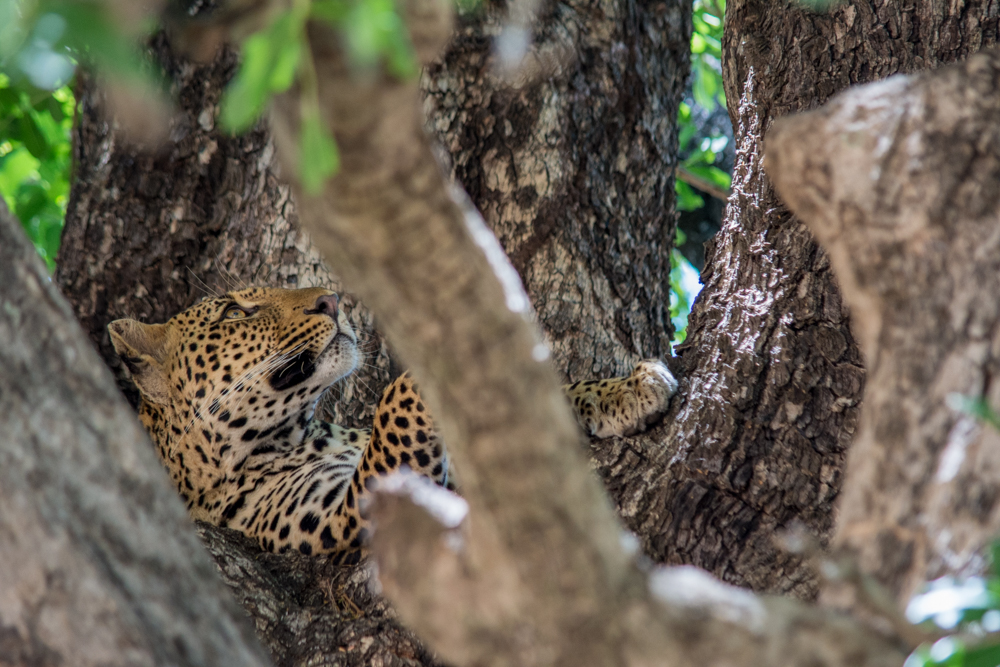
Sadly we didn’t spot any leopards on our walk, but when you’re back at camp by eight o’clock after a morning stroll, there’s more than enough time to catch up on sightings like this beauty in the afternoon. Photo by Melanie van Zyl.
2. Pafuri Cross-Border Trail
At the northern tip of Kruger National Park is Pafuri, a region of unparalleled beauty. Comprising roughly one percent of Kruger’s area, it’s home to plants and animals representing almost 75 percent of the park’s diversity. This is Africa condensed.
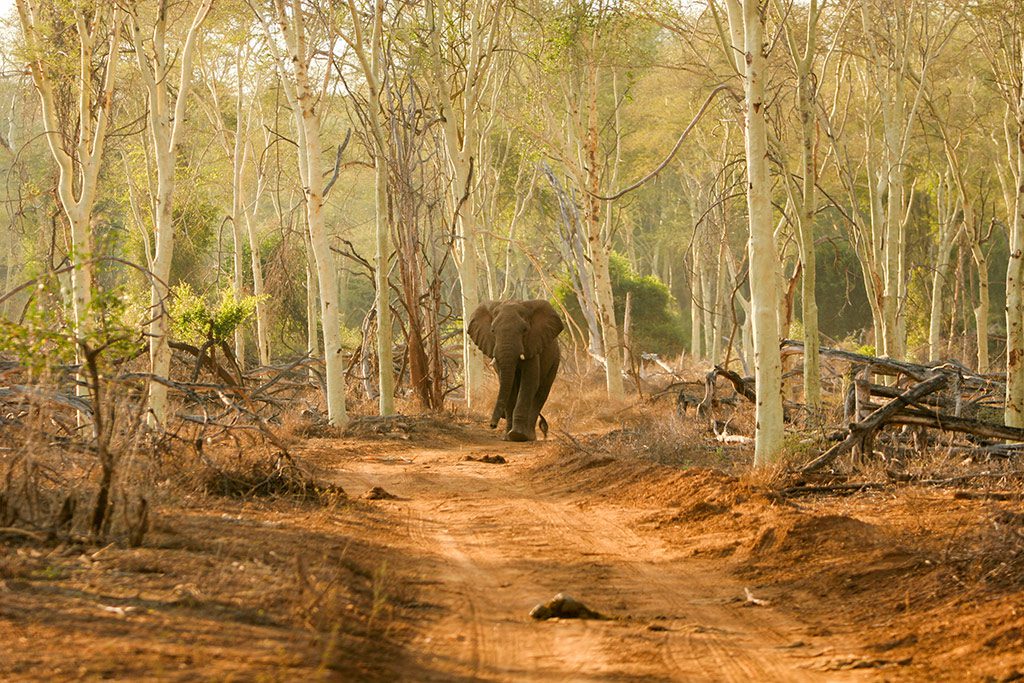
Photo by Simon Stobbs.
Walking trails here take you through one of Africa’s largest fever-tree forests as well as riverine fig forests, thorny woodland guarded by immense baobabs and river gorges deep enough to block out the sun. Such diversity attracts a huge variety of animals, insects and birds – it’s a twitcher’s delight with over 450 species.
But what attracted us most was a walk into another country. Straddling Zimbabwe and Mozambique, Pafuri is part of the Great Limpopo Transfrontier Conservation Area, and the motivation behind this walk – run by Return Africa – is to break down wildlife and culture barriers.
After emerging from Pafuri’s enchanting fever-tree forest, we walked across the dry Limpopo riverbed to attend a Shangaan festival in Zimbabwe. This annual event is funded by proceeds from the walk and is a way of showing appreciation for the society that is part of this conservation area. Shangaan dignitaries from South Africa walked with us, and people from all over the region congregated at a local school to celebrate their culture with song and dance. The pride of the youngest dancers was infectious and we were enthralled by the large audience whose traditional outfits enhanced the festive atmosphere.
Song and dance is not Return Africa’s only community initiative. The land south of the Limpopo is leased from the community; they also own 25 percent of the business and receive 10 percent of annual turnover and preferential employment. Walking back across the Limpopo that evening, we watched the setting sun playing on the green bark of the fever trees so tall that elephants looked like dwarves beneath them. But they’re not so small up close. Herds of elephant walked through our tented camp every afternoon. One female locked eyes with us. She was so close we could study her tear ducts and smell her odour. Then she silently moved on. We felt vulnerable but grateful for her acknowledgment, a powerful reminder that she was allowing us into her space and that we might be welcome if we work in concert to protect her kind.
Useful info about the Pafuri Cross-Border Trail
Each walk is roughly five to six kilometres and takes three to four hours. Guests are driven to and from camp between walks. The cross-border walk has a long stop in Zimbabwe where one can enjoy the cultural festivities. This is a full-day affair. No climbing or bundu-bashing is involved, but relative fitness is recommended. Bring binoculars, a camera, sunscreen, a hat, comfy walking shoes and neutral, dark clothing. The dates for the 2016 Cross-Border Trail are 23 to 26 September.
Cost:From R7800 per person sharing for three nights including cross-border walk and festival, all meals and twice-daily activities, contributions towards the community but excluding visas. Regular Pafuri walking safaris are R5458 per person sharing for three nights including all meals and twice-daily walks and are doable from April to October.
Book: Tel 0116461391, returnafrica.com
Also read: The first steps towards a tourist crossing between Kruger and Zimbabwe?

Left: a dung beetle scouts the surroundings for obstacles while rolling his precious ball of life to safety. Right: We had an exceptional sighting of an elephant, so close we could hear him crunching his food. Photo by Melanie van Zyl.
Walking trails for those staying in Kruger
Did you know the following? You shouldn’t pick up tortoises – they keep a special reserve of water in a sac at the rear of their bodies and if disturbed they can dehydrate; dung beetles lay 60 eggs – one per ball of dung, which they then have to roll up hills and over rocks before being buried and, in all likelihood, dug up in winter by hungry honey badgers; hippos move like people in early-morning slippers, dragging their feet in the dirt, thereby creating ‘hippo highways’ with a ridge in the centre. These are some of the things visitors learn on Kruger’s morning walks. Melanie van Zyl picked the best to do. All of these can be booked on sanparks.org
Morning walks from the main camps start at 5am and cost R484 per person (rates include a drink and snacks).
3. Pretoriuskop day walk
Koppies and valleys abound at Kruger’s oldest rest camp where you can spot sable and brown-headed parrots. Pretoriuskop is easily the lushest part of the park at the moment and the fresh green morning was a welcome change from the drier north. Here, we witnessed an enormous breeding herd of buffalo and spotted giraffe moving along the granite ridges.
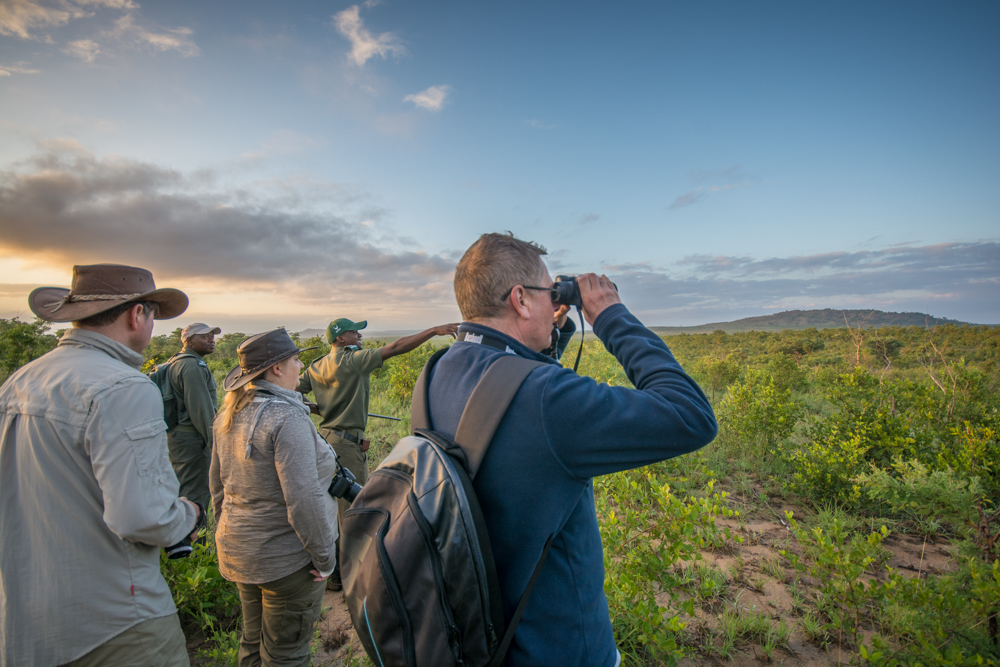
You can immediately see the more lush surroundings of Pretoriuskop. On this morning walk the light was purple, the grass green and happiness levels high. Photo by Melanie van Zyl.
4. Lower Sabie day walk
The Lower Sabie is a wildlife hotspot in the southern Kruger savannah. The route is based at the Sabie River and walks are commonly led alongside the lively waters. Dawn was yet to break and our guides got out of the vehicle as two lion emerged from the slopes and we had to wait for them to saunter off before beginning our walk. The two males didn’t linger and the guides assured us they’re far more likely to steer clear of us than lie in wait.
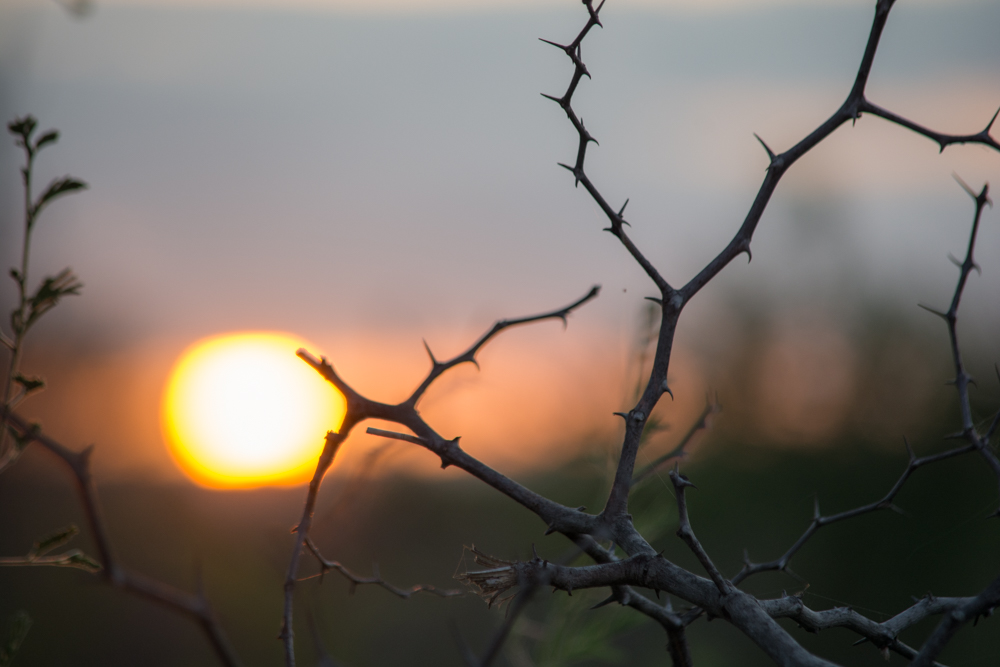
Photo by Melanie van Zyl.
5. Skukuza day walk
Get away from the traffic at Kruger’s busiest area and peep through thorn thickets at the rising sun and enjoy the flat, easy-walking terrain. Skukuza is known as a wildlife hotspot and was the busiest of all the walks I went on. We tracked two rhino and watched them graze from atop an anthill for at least seven minutes before a camera click finally gave us away. I was going to change my booking to an afternoon walk, but both receptionists advised I stick to the morning because afternoons tend to be much hotter and the activity of the animals is less. Afternoon walks from Skukuza leave at 4pm and cost R478 per person.
Walks for day visitors in Kruger
Morning walks for day visitors cost R555.50 per person and walkers meet their guides at the respective gates at 5am before being taken into the park.
6. Crocodile River walk
Great for day visitors looking for another way to experience South Africa’s famous wildlife park. Generally speaking, this southern edge of Kruger is good for seeing the Big Five, wild dog and cheetah. There aren’t wilderness trails in this area so it’s the only way you’ll see this part of the park on foot.
7. Orpen’s morning walk
A wonderful way for visitors to experience the quieter side of southern Kruger, with the best chance for spotting plains game and cheetah. Scattered trees and wide-open plains make it a great option for a morning walk that’s just far enough away from the buzz of southern Kruger to feel like it’s untrammelled. Grazers favour this area because it’s open, and ostensibly safer. This also makes it a good hunting ground for cheetah. It’s unlikely you’ll experience that kind of action, but following the highway carved by moving elephant the night before and stopping to examine spoor is an excellent way to experience this lesser-visited area.
8. Olifants short walk
Spot crocodiles, hippo, elephant and water birds on this short, mid-morning walk that will appeal to the not-so-early risers. Olifants Rest Camp offers a two-hour mid-morning walk that’ll get you down onto the banks of the wide river. Expect to see hippo and crocodile up close. And because it starts at 9.30am, day visitors entering at Phalaborwa Gate are able to do the walk. Malelane, Phabeni, and Phalaborwa also offer morning walks for day visitors. It’s also more affordable at R262.60 per person.
Getting to Kruger
The easiest way to get to Kruger from Gauteng is via Nelspruit. Be sure to opt for the Schoemanskloof turn-off after Machadodorp on the N4 to avoid roadworks. The road via Bushbuck Ridge isn’t great, so drive slowly and watch out for straying cars on the unlined roads. If heading north towards Phalaborwa Gate then head up the N1 and turn off at Polokwane towards Tzaneen.
Need to know
Trained field guides armed with rifles take adults and children over 13 out into the bush (maximum eight people). Morning walks generally last four hours but are easy-going; most are less than four kilometres with a break for snacks (you also score an early-morning game drive to catch nocturnal sightings of animals such as hyena before the walk as you are driven about half an hour to the departure point). Afternoon walks are shorter (about two hours). Bring binoculars, a camera, comfy walking shoes and neutral, dark clothing and a hat.
Read the full story in the April 2016 issue of Getaway magazine.
Our April issue is packed full of great holiday ideas for 2016. Get your copy today.
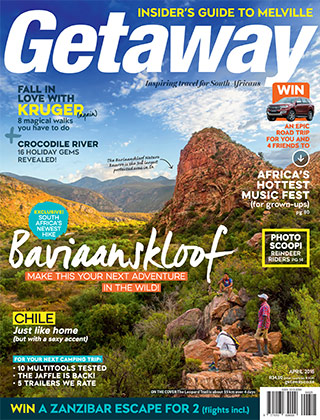
This article, The best walking trails in Kruger, was originally posted on the Getaway Blog by Melanie van Zyl.